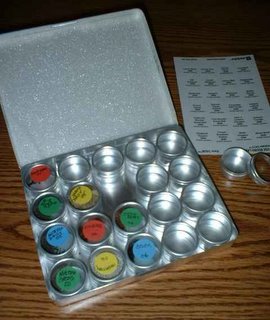 After ordering an average of $20 in seeds each year, I'm loathe to waste them. Now, $20 may not seem to be much for garden plants, but why should I order the same seeds every year when I can get a few years off each packet, and even more years worth by allowing a few plants to go to seed every year?
After ordering an average of $20 in seeds each year, I'm loathe to waste them. Now, $20 may not seem to be much for garden plants, but why should I order the same seeds every year when I can get a few years off each packet, and even more years worth by allowing a few plants to go to seed every year?I use a watchmaker's case to store the seeds. This one was purchased for about $5 at American Science and Surplus, but they can be ordered online. The set has one large aluminum box, with foam padding in the lid, and twenty small aluminum cases with glass windows and friction-fit lids. The cases come in a variety of sizes and can be ordered online from Lee Valley Tools. This small size is 33mm diameter, and holds about a tablespoon. Larger seeds such as beans or corn might do better in larger cases.
 Since identifying seeds is not a strong suit of mine, I choose to label each container. White or colored 3/4" inkjet labels are perfect for this. I can print out a whole sheet of labels when the seed order comes in, and use only what I need to store. Using removable labels makes recycling containers easier.
Since identifying seeds is not a strong suit of mine, I choose to label each container. White or colored 3/4" inkjet labels are perfect for this. I can print out a whole sheet of labels when the seed order comes in, and use only what I need to store. Using removable labels makes recycling containers easier.Mark the seeds with the year they were intended to plant, or the year following harvest (if you collect your own). This will help predict germination rates when you use them the following year. I keep the entire box of seeds in an unheated corner of my basement, which stays around 50-60 degrees year round. If moisture is a problem, use a packet of desiccant to absorb the humidity (found in shoe boxes, packing materials, etc, and labeled "desiccant do not eat"). It can be purchased at craft and hobby stores under the names Silica Gel and Calcium Oxide.
Never saved seeds before?
It's only as difficult as you choose to make it. The easiest seeds to save are dry beans and corn, which can ripen on the plant naturally and be collected at will. Some plants, like parsley and dill, can be saved by tying a bit of row-cover around a nearly-ripe seedhead. Let the plant naturally ripen and dry the seeds, and collect them. Other plants, like tomatoes, require the seeds to ferment for a few days before drying. Books such as The Seed Saver's Handbook or Seed to Seed can be valuable resources. Online resources are also available, such as the International Seed Saving Institute, where you can find directions for many common vegetables.
--

1 comment:
wow that's pretty cool! i wonder if you can have aluminum cases custom made for this sort of thing. it's a great idea!
Post a Comment